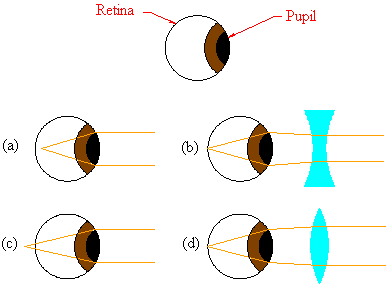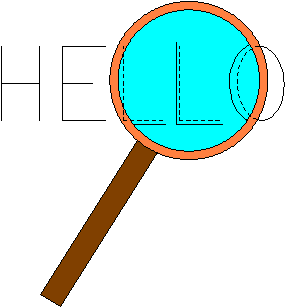سارة أيمن
Admin



عدد المساهمات : 5871
العمر : 28
الموقع : --------------
العمل/الترفيه : طالبة
فصل : :'(
المزاج : disappointed
مزاجي اليوم : 
المهنة : 
الهواية : 
أوسمة العضو : 
نقاط : 31380
السٌّمعَة : 201
تاريخ التسجيل : 06/12/2008
 |  موضوع: Applications of Lenses موضوع: Applications of Lenses  الإثنين أكتوبر 25, 2010 4:25 pm الإثنين أكتوبر 25, 2010 4:25 pm | |
| The Human Eye and Corrective LensesA greatly simplified view of the human eye is shown below. The pupil is a little hole which allows light to pass into the eye. Behind the pupil lies the eye's lens. Muscles in the eye control the size of the pupil and the shape of the lens, thereby adjusting the amount of light that enters they eye and the focus of the lens. The retina is a sensitive layer of nerves at the back of the eyeball; incident light upon the retina is translated into a coherent image by the brain.  Many people do not have perfect vision; that is, a lot of people have eyes whose lenses do not focus light properly on the retina. Two well-known vision problems correctible via eyeglasses are nearsightedness (picture (a) above) and farsightedness (picture (c)). Nearsightedness focusses rays of light in front of the retina, while farsightedness focusses rays behind the retina. A diverging lens can correct nearsightedness by bending incoming light rays outwards, so that the eye's lens (which usually bends incoming rays too much) focusses the light closer to the retina (picture (b)). A converging lens similarly corrects farsightedness (picture (d) Magnifying GlassesIn our study of lenses, we saw that if the source was placed within a focal length of a converging lens, the lens yielded a magnified image on the same side of the lens as the source. This is, of course, the detective's best friend, the magnifying glass.  The amount of magnification, as we know from our treatment of lenses, depends on the distance of the source from the lens, and the refractive index of the lens material. CamerasCameras, unsurprisingly, work on similar principles as the eye.  The aperture, which lets light into the inside of the camera, corresponds to the pupil. The system of lenses in a camera performs the same function as the lens of the eye. However, whereas the lens of the eye changes shape to change focus, glass lenses are not very forgiving of shape changes. Instead, the lens system can be slid along its optical axis in order to focus on the film. Of course, the film plays the role of the retina. In addition, cameras have a shutter, which opens and closes quickly so that the film does not get inundated with light. This produces a more or less clear image of the instant that the photographer shoots. copied  | |
|









